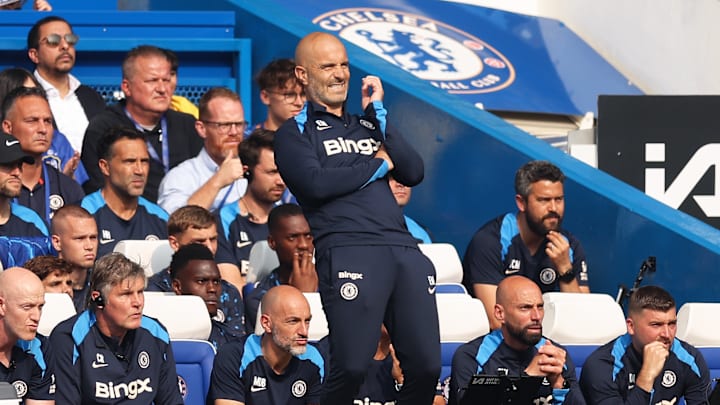Chelsea's Premier League opener against reigning champions Manchester City did not unfold as hoped. The Blues faced a 2-0 defeat at Stamford Bridge, with goals from Erling Haaland and Mateo Kovacic securing City's win.
In this analysis, The Pride of London will delve into the tactical aspects of the match and explore how both teams approached the game.
Chelsea VS Manchester City Tactical Analysis
— Fahd (@fahdahmed987) August 18, 2024
The Chelsea Blueprint – Premier League Match Day 1
An opening-day tumble against the reigning champions
Detailed Thread 🧵 pic.twitter.com/lTak5oFXmM
Chelsea's Build-Up Shape
From the start, Ederson's long ball to Robert Sanchez set the tone for Chelsea’s build-up. The Blues lined up with a 4-2 base against City’s 5-man press. Initially, Chelsea struggled to play out from the back, leading to turnovers or long balls to evade pressure.
Despite these issues, there were moments when Chelsea managed to exploit City's high line, finding runners behind the defense. Additionally, the fullbacks often found space, though consistent success in build-up play was limited.
Chelsea's Build-Up Shape
— Fahd (@fahdahmed987) August 18, 2024
Ederson hit a long ball to Sanchez as soon as the game started, and we immediately saw the Blues' build-up shape. Chelsea, as expected, built with a 4-2 base against City's 5-man press. pic.twitter.com/4gLXbiHCvO
Chelsea In-Possession
Chelsea’s in-possession shape was predominantly a lopsided 3-2-5, with Marc Cucurella sometimes positioned higher. In the first half, Malo Gusto's positioning was less aggressive, but he advanced more in the second half, creating potential vulnerabilities in transitions.
Despite creating chances, Chelsea lacked the cutting edge to convert clear opportunities, though their possession and rotations improved after the break.
This was another game where the FB didn't invert. Instead, Gusto was on the Right interchanging/combining with Palmer whilst Lavia & Caicedo formed the pivot.
— stb ☾ (@cfc_stb) August 19, 2024
The principles are the same. 4-2 deep build-up + Box midfield formed by Enzo & Palmer tucking in (3-2-5) pic.twitter.com/JNOFj2YufZ
Manchester City Press
City employed a high press from the start, maintaining intensity even when Chelsea had possession in the middle third. They aimed to disrupt Chelsea’s build-up and prevent them from establishing a stable in-possession shape.
As the game progressed, City’s press became less intense but remained effective. For example, there was moment in the first half when City initially sat off Chelsea, then intensified their press. However, Chelsea managed to play through it at times, creating attacking opportunities.
Chelsea 0 : 2 Man City
— markstats bot (@markstatsbot) August 18, 2024
▪ Penbox shots: 6 - 6
▪ Deep completions: 12 - 10
▪ Buildup completion: 88.5% - 91.7%
▪ PPDA: 10.4 - 14.0
▪ High turnovers: 6 - 7 pic.twitter.com/7Wv41y06es
Manchester City In-Possession
When City gained possession, they faced a Chelsea mid-block, which often settled into a 4-4-2 shape. City's structure varied throughout the game, adapting to Chelsea's defensive setup. The key issue for Chelsea was being overloaded in midfield and defense, with potential overloads on the wings if City effectively circulated the ball. City aimed to create 1v1 situations on the flanks.
Early on, Doku struggled against Cucurella, prompting Guardiola to switch him with Savinho, who proved more effective.
Manchester City In-Possession
— Fahd (@fahdahmed987) August 18, 2024
City, on the other hand, after winning the ball, would not immediately face a highly intense OOP team as Chelsea often sat back and settled into a 442 mid-block.
Below is City's structure in the 4th minute but it changed a lot during the game and in… pic.twitter.com/YC0Er5ZSVE
Chelsea's Press
Chelsea’s high press, when City built from goal kicks, involved four players closing down City’s seven (including the goalkeeper). This approach led to some turnovers and long balls from City, but overall, City was comfortable playing out from the back.
Chelsea’s press did occasionally cause problems, resulting in turnovers and counter pressing opportunities. Despite some sharp moments, City’s ability to play through the press was evident, with Chelsea falling back into a mid-block 4-2-4 when City settled into their in-possession shape.
City’s Transitions
City was notably aggressive in their attacking transitions, exploiting Chelsea’s defensive organization. Their rotations were highly effective, as seen when De Bruyne and Savinho interchanged positions, confusing Chelsea’s defenders and creating shooting opportunities for Silva.
Silva and De Bruyne had the freedom to roam, which created space for their teammates if Chelsea attempted to track them.
City's Transitions
— Fahd (@fahdahmed987) August 18, 2024
City was surprisingly aggressive with their attacking transitions as they quickly looked to attack Chelsea's rest defense at times. And they were quite effective too. pic.twitter.com/JyvNjwNFtl
Tactical Conclusions & Final Thoughts
City demonstrated superiority in all phases of play, though Chelsea showed positive signs, particularly in transition, counter pressing, and occasional build-up success under pressure. Despite the disappointing result, Chelsea’s performance was not drastically inferior to City’s.
The Blues are a work-in-progress, and gradual improvements will be necessary, especially in pressing and possession, as they prepare for their upcoming matches against teams like Wolves.
